I wouldn't claim to know what he means, but pretty close are the series of amps by Stochino in Electronics World (AKA Wireless World) October 1995, April 1997, August 1998. There was also one in March 1996 that I don't have handy.
Do you know these or were they about the time you were out of the scene?
VFA with 300v/usec, not that it matters, but the discussion is educational.
Best wishes
David
Stochino was a VFA with MIC type compensation - thats the way you can get these high SR's with VF because the comp cap is usually much smaller than you would use in MC.
Last edited:
Thanks for this Damir.
Gotta point out that Bonsai's simple CFA nx-Amp is already very close to Stochino's performance and can easily exceed it in ALL respects with slight modification.
Bonsai also has sensible ULGF while Stochino exceeds even Loony Lee's which Guru Zan has condemned. 😱
If Stochino's complexity is the price for zillion V/us with a VFA, this is further boost to da CFA supporters. 🙂
Does Stochino show overload behaviour on his amps?
I took a look at Damir's link.
Stochino's amp is stock standard MC VFA. He achieves this by running the LTP tail current at 12mA (in practise its probably a bit higher than this). From it=CV, I get a SR of 250 V/us assuming +-60 V rails - so the claimed 300 V/us is quite within reach.
There's a lot of anti saturation and clipping nasties mitigation going on in the TIS and no doubt this is because of the huge OLG - 120dB at DC - which is very high for a power amplifier. Interesting, the distortion performance, despite the high gain loop gain (60 dB at 20 kHz claimed), is not at the same level as a lot of amps on the forum . . . we seem to have got that one licked here in the last few years 😉
The loop gain is closed at 1MHz - so nice and conservative. The CLG ULGF however is at 22 MHz - very high and again a reflection of the high OLG.
As you note Richard - very complicated for what you get . . . the older I get, the more appealing refined simplicity seems (thanks for the plug BTW 🙂 )
Stochino's amp is stock standard MC VFA. He achieves this by running the LTP tail current at 12mA (in practise its probably a bit higher than this). From it=CV, I get a SR of 250 V/us assuming +-60 V rails - so the claimed 300 V/us is quite within reach.
There's a lot of anti saturation and clipping nasties mitigation going on in the TIS and no doubt this is because of the huge OLG - 120dB at DC - which is very high for a power amplifier. Interesting, the distortion performance, despite the high gain loop gain (60 dB at 20 kHz claimed), is not at the same level as a lot of amps on the forum . . . we seem to have got that one licked here in the last few years 😉
The loop gain is closed at 1MHz - so nice and conservative. The CLG ULGF however is at 22 MHz - very high and again a reflection of the high OLG.
As you note Richard - very complicated for what you get . . . the older I get, the more appealing refined simplicity seems (thanks for the plug BTW 🙂 )
Last edited:
This approach is still trying to use imprecise labels to divide varied topologies into two categories. Of course it become convenient to affix labels, then to affix a way of approaching the design and analysis. But when we also try to claim one is better than the other we create confusion and argument. It's no different in politics - polarization around concepts that are used to divide people into two camps - which doesn't help. The history of this thread surely shows that there is a fundamental problem with the idea that amplifiers can be divided between these two camps and that one is better than the other.
Very good comparison with politics.
I completely agree with this extremely clear and clever view on this thread. I feel rather upset when I read constant claims of better sounding for a topology and so little investigations which could substantiate them.
Pay attention to the output stage. Taken separately output stage distortion is less than the output stage with error corrector Hawksford
http://zalil.ru/34849517
best regards
Petr
http://zalil.ru/34849517
best regards
Petr
Hi Andrew,
Here is another link to the schematic. As you can see, it is not just a standard VFA, rather a VFA with some 'current on demands' properties, that is, to a certain extent. This has been accomplished by means of a cross coupling resistor (and capacitor), see pic below.
Cheers, E.
I took a look at Damir's link.
Stochino's amp is stock standard MC VFA. He achieves this by running the LTP tail current at 12mA (in practise its probably a bit higher than this). From it=CV, I get a SR of 250 V/us assuming +-60 V rails - so the claimed 300 V/us is quite within reach.
Here is another link to the schematic. As you can see, it is not just a standard VFA, rather a VFA with some 'current on demands' properties, that is, to a certain extent. This has been accomplished by means of a cross coupling resistor (and capacitor), see pic below.
Indeed, there are a lot of clamping diodes, which protect the TIS against deep saturation. But what has this to do with a 'huge OLG'? I think they are needed because the IPS is capable of delivering pretty large currents (according to Stochino <= 18mA).There's a lot of anti saturation and clipping nasties mitigation going on in the TIS and no doubt this is because of the huge OLG - 120dB at DC - which is very high for a power amplifier.
Cheers, E.
Attachments
Pay attention to the output stage. Taken separately output stage distortion is less than the output stage with error corrector Hawksford
http://zalil.ru/34849517
best regards
Petr
Could you, please show the schematic, not the link to the dangerous page
Yes, that 200ohm and 1nF (for HF) makes it able to do current on demand and the current sources turn the input stage to get higher gain than only H configuration.
No, please, you were boring enough the first time.I would not rant again about the sub mediocre electrical performances of the VSSA.
May-i make a suggestion ? One day, plug an amp in the power outlet and listen some music. You will see, it is very nice.
Why don't you begin your own investigations: building and listening to CFAs to understand what we are talking of (on a 'signature' point of view)?I feel rather upset when I read constant claims of better sounding for a topology and so little investigations which could substantiate them.
... Stochino exceeds even Loony Lee's which Guru Zan has condemned. 😱
Condemned, no, just questioned.😉
If Stochino's complexity is the price for zillion V/us with a VFA, this is further boost to da CFA supporters. 🙂
Does Stochino show overload behaviour on his amps?
There are actually lots of different Stochino amps, four articles each with a discussion of various options.
But all more or less complex. As Edmond notes, some of the complexity is due to quite elaborate precautions for anti-saturation and the like.
So he does some to have taken overload seriously, even if not much is demonstrated.
As I said, of educational interest. He discusses the current on demand, more to it is than Andrew has noticed.
Not that I don't like MIC. Probably all you need for any real audio amp.
Stochino's amp started out as an instrumentation unit.
The rest was for the fun I suspect.
Best wishes
David
Could you, please show the schematic, not the link to the dangerous page
 [/URL]
[/URL]
best regards
Petr

best regards
Petr
unable to insert the normal size
<a target="_blank" href="http://radikal.ru/fp/fa57f4d60129417786db9bde7a19ed78"><img src="http://s019.radikal.ru/i6
petr
<a target="_blank" href="http://radikal.ru/fp/fa57f4d60129417786db9bde7a19ed78"><img src="http://s019.radikal.ru/i6
An externally hosted image should be here but it was not working when we last tested it.
petr
Member
Joined 2009
Paid Member
someone should build a damn amp.... OS
I'm just waiting for pcb's to come back on a 'complimentary singleton input' amp with a truck load of open loop gain - should be interesting (see my TGM7 thread).
In the case of CFA you are up against, the designers/inventors at Comlinear, TI, AD, LT etc etc as well as academics and researchers and many published works on the subject... technical papers and books.
I'm not against anything or anybody, but those trying to promote unsubstantiated subjective nonsense to the level of absolute truth. Starting any such statement with an "in my opinion" will do fine.
I am though also not driven by a marketing engine, always trying to re-invent the wheel for a profit.
- Home
- Amplifiers
- Solid State
- CFA Topology Audio Amplifiers





